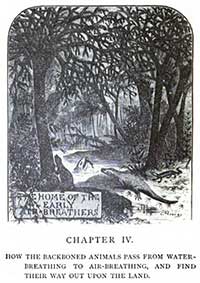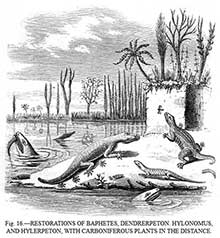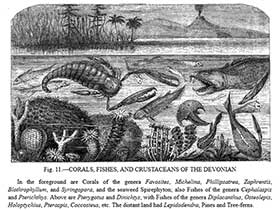
Representing Evolution: A Case Study
in Visual Narrative
- Richard Somerset
_______________________________

Fig. 12. Th. Carreras, “The Home of
the Early Air Breathers”, Winners in
Life’s Race, 1882 

Fig. 13. “Carboniferous Reptiles”, J. W.
Dawson, The Story of the Earth and Man, 1873 

Fig. 14. “Life in the Devonian”, J. W. Dawson,
The Story of the Earth and Man, 1873 
The ‘picture heading' for chapter four shows a typical ‘coal-forest' scene (fig. 12) which resembles Figuier’s equivalent illustration, already reproduced (fig. 2  ). In both cases, the scene is dominated by a dark, swampy forest consisting of the same characteristic vegetation, and inhabited mainly by amphibians. Although the format of Buckley’s illustration differs from Figuier’s, the setting is clearly derivative. The animals, on the other hand, come from a different – acknowledged – source. The author in question is J.W. Dawson, a Canadian naturalist and educator who produced semi-technical and popular works in the 1860s and 1870s arguing against evolutionary theory. The illustration that Buckley borrowed from had been produced by Dawson for use as the frontispiece to his Air-Breathers of the Coal Period (1863), and as an illustration in his popular ‘History of Life', The Story of the Earth and Man (1872) (fig. 13).
). In both cases, the scene is dominated by a dark, swampy forest consisting of the same characteristic vegetation, and inhabited mainly by amphibians. Although the format of Buckley’s illustration differs from Figuier’s, the setting is clearly derivative. The animals, on the other hand, come from a different – acknowledged – source. The author in question is J.W. Dawson, a Canadian naturalist and educator who produced semi-technical and popular works in the 1860s and 1870s arguing against evolutionary theory. The illustration that Buckley borrowed from had been produced by Dawson for use as the frontispiece to his Air-Breathers of the Coal Period (1863), and as an illustration in his popular ‘History of Life', The Story of the Earth and Man (1872) (fig. 13).
Roughly speaking, Buckley’s ‘picture heading' was constructed by the simple expedient of transposing Dawson’s creatures into Figuier’s very different landscape. Even the attitudes of Dawson’s animals are replicated, along with the footprints made by the largest lizard-like beast. However, the interaction of the beasts with their environment has a significant impact. In Dawson’s scene that interaction is minimal, and even the creature standing on its hind legs to grab at an insect seems frozen in an attitude calculated to display its anatomy. When placed by Buckley in the setting inspired by Figuier, however, the arrangement of the beasts is more apt to hint at an implied narrative. The receding waterway in the centre of the composition, already present in Figuier, becomes a sort of pathway for this narrative. In the distant background a small head is just visible in the water; nearer-by a larger head emerges more distinctly, and in the foreground two lizard-like creatures have emerged from the water to walk on the land, which is duly marked with their imprint. Finally, Dawson’s upright insect-chasing reptile is placed in a ‘frame-breaking' position sitting on the ostensibly conventional title element, and propped up on a tree which he seems to be preparing to climb. If there were any doubt as to the general tendency of the implied narrative in this illustration, the point is immediately clarified by the textual heading appearing immediately below: “How the back-boned animals pass from water-breathing to air-breathing, and find their way out upon the land.” Taking material used by two authors working to tell a story of life marked by periodic discontinuities, Buckley was able to rearrange that material to make it do just the opposite: to hint at a story of gradual progress leading to frontier-breaking innovations. As for the text of the accompanying chapter, it does not explicitly build on these themes; instead it concentrates on the description of modern amphibians, paying particular attention to the metamorphosis of tadpoles.
Another case of potential borrowing by Buckley from Dawson is worth mentioning but this time we are interested in their marked difference. This concerns the ‘picture heading' for chapter two which deals with the fish as a class, already reproduced as figure 10  , which we will compare to the equivalent depiction of the age of the fish in Dawson’s Story of the Earth and Man (fig. 14). The one obvious shared feature of the two illustrations is the prominent positioning of the giant crustacean Pterygotus, again in a similar attitude. But other than this one central element, everything else is different. Most importantly, Dawson does not show just one crustacean and one type of fish; on the contrary, his scene is positively crammed with a huge variety of fish and crustacean species, as well as corals and plants. Despite the presence of certain naturalising elements such as the volcano in eruption and the confrontation between the two largest beasts, the cramming of the frame is such that the scene looks more like a frozen display of specimens.
, which we will compare to the equivalent depiction of the age of the fish in Dawson’s Story of the Earth and Man (fig. 14). The one obvious shared feature of the two illustrations is the prominent positioning of the giant crustacean Pterygotus, again in a similar attitude. But other than this one central element, everything else is different. Most importantly, Dawson does not show just one crustacean and one type of fish; on the contrary, his scene is positively crammed with a huge variety of fish and crustacean species, as well as corals and plants. Despite the presence of certain naturalising elements such as the volcano in eruption and the confrontation between the two largest beasts, the cramming of the frame is such that the scene looks more like a frozen display of specimens.
Empirically speaking, Dawson’s is the more complete picture: his picture captures more fully the range of species that existed in the Devonian seas. But Buckley’s illustrations were designed for narrative not empirical purposes. She got rid of all the ‘excess' creatures in order to facilitate the construction of a clear narrative about the passage of ‘Life' from its crustacean to its piscine age. Her illustration was designed to dramatise this ‘frontier-breaking moment'. Dawson’s illustration, by contrast, did just the opposite. As an opponent of developmentalism, his preoccupation was to exclude any hint that the animal economy might be formed in response to a process of naturalistic change. So the cramming of the frame works as a way of stifling and preventing any such narrative from taking shape. The central confrontation between the Pterygotus and an equally virile fish has just the same impact. What we see here is a world already complete and adequate in itself, not a transitory state of affairs out of which some other and more adequate state is anticipated to emerge. Dawson crammed his frame with species to stifle the temptation to discern in specific differences an implied narrative of emergence; Buckley, for her part, freed up the frame and reduced the protagonists to two in pursuit of just the opposite effect.
This brief survey has given us the occasion to compare three distinct strategies of narrative-management by visual means in the genre of the popular or educational ‘History of Life'. We have seen how Figuier used contrasted naturalistic scenes from deep time in order to create the impression of narrative discontinuity; and, briefly, how Dawson filled at least one of his scenes with a plethora of species in order to stifle the possibility that the confrontation of crustacean and fishes might be interpreted as implying a narrative of progress through competition. In contrast to these two fixist authors, we have seen how Buckley the evolutionist worked out a markedly different strategy based not on naturalistic representations of the past but on a stylised attempt to address the theme of categorial change in nature. The fixists used naturalistic representation to build a plot-free natural narrative; the evolutionist used stylised representation to assert against that familiar orthodoxy the inherent plottedness of nature and its operations. For all of them, illustrations played a critical role in constructing the natural narratives that their conceptual outlooks required since they offered the most effective space within which to naturalise those concepts. We therefore cannot properly read these Histories of Life if we do not read the pictures as well as the text.
Works Cited
– Arabella Buckley, Life and Her Children: Glimpses of Animal Life from the Amoeba to the Insects, London, Stanford, 1880.
– Arabella Buckley, Winners in Life’s Race or the Great Backboned Family, London, Stanford. 1882.
– Georges Cuvier, Recherches sur les ossements fossiles, Paris, Déterville, 1812.
– J.W. Dawson, The Story of the Earth and Man, New York, Harper Brothers, 1873.
– Louis Figuier, La Terre avant le Déluge, Paris, Hachette, 1863.
– Louis Figuier, The World Before the Deluge, London, Chapman & Hall, 1865.
– Martin Rudwick, Scenes from Deep Time: Early Pictorial Representations of the Prehistoric World, Chicago, University of Chicago Press, 1992.
– Martin Rudwick, Worlds Before Adam: The Reconstruction of Geohistory in the Age of Reform, Chicago, University of Chicago Press, 2008.
– Richard Somerset, ‘Textual evolution: the translation of Louis Figuier’s La Terre avant le déluge’, The Translator, Volume 17, Number 2, 2011, pp. 255-74.
– Richard Somerset, ‘Arabella Buckley and the Feminisation of Evolution as a Communication Strategy’ in Nineteenth-Century Gender Studies, Special issue: “Women Write the Natural World”, summer 2011.


